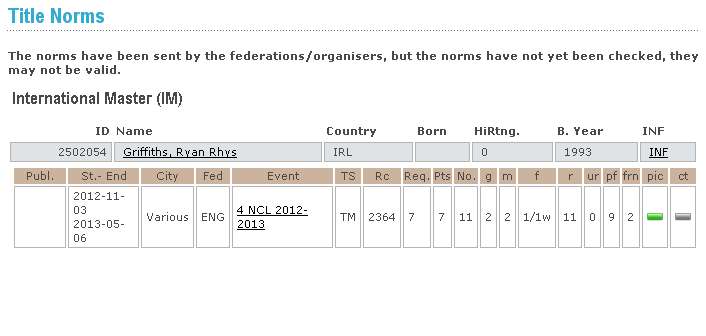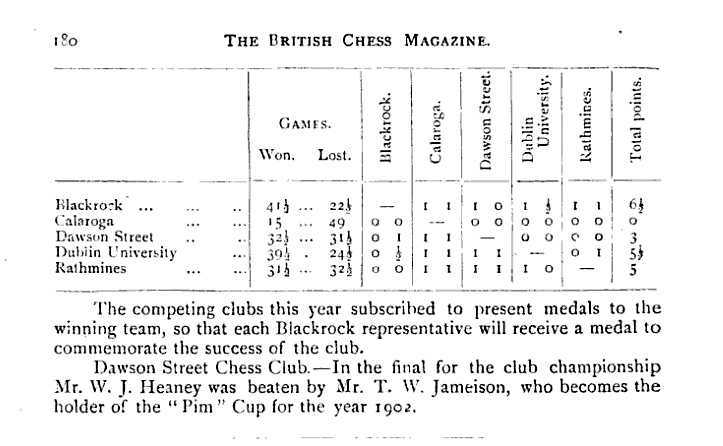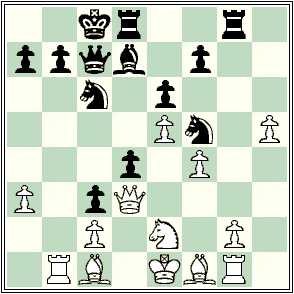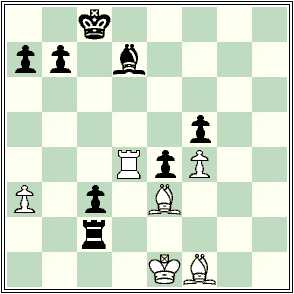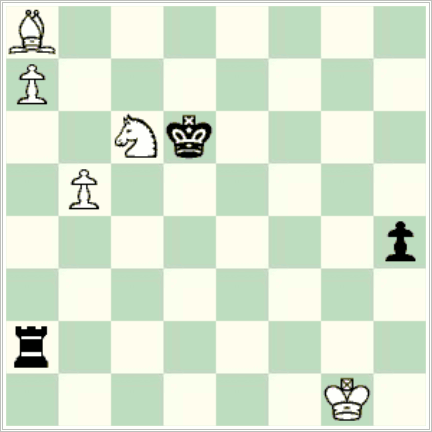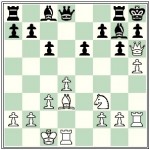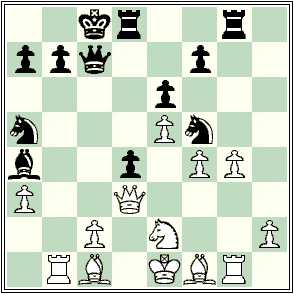The 1940 Irish Championship was affected by the late withdrawal of the two Ulster representatives, A.L.Davies and J.D. Peebles, because they were unable to travel to Dublin. As the Second World War continued into 1941, the Irish Chess Union Council decided, as the Ulster Chess Union was unable to be represented, to suspend the Irish championship for that year and replace it with a new competition, described as “the Dunsany Premier Tourney.”
The tournament was arranged to take place at the Dublin Chess Club from Monday 21st to Saturday 26th July and to be played on very similar lines to the Irish Championship with two four-hour sessions each day. Lord Dunsany, the President of the ICU, provided three valuable prizes.
There was a strong entry with the 1940 Champion, J.J. O’Hanlon, plus the four players who only finished a half-point behind him – C.J. Barry, Austin Bourke, Gerard Kerlin and Warwick Nash – all taking part. Two-time Irish champion, T.G. Cranston, who had not competed in 1940, was a strong addition.
The surprise of the first two days was O’Hanlon losing both his games on the Tuesday to Nash and Barry and it was Kerlin who was making the running, having won 4 games. On the Wednesday evening the second session was reserved for adjourned games to be played off and Kerlin was then held to a draw by O’Hanlon but still enjoyed a comfortable lead.
Standings after Round 5 and adjourned games played off:
G. Kerlin 4.5
T.G. Cranston 3.0 + 1 adj
W. Nash 3.0
J.J. O’Hanlon, L.J. Close 2.5
A. Bourke, R.T. Varian, C.J. Barry 2.0
T.A. Vard 1.5 + 1 adj
S.A. French 1.0
Day 4 on the Thursday and the tournament was thrown wide open again after Kerlin lost to both Cranston and Bourke respectively in Rounds 6 and 7. Despite this he was still a half-point ahead of Nash, Barry and Cranston, though the last-named had two adjourned games in hand.
Cranston fell out of contention for first by losing both his games on the Friday. Barry, his Round 9 conqueror, finished with 4 straight wins and posted a total of 6 points. Front-runner Kerlin had drawn in the Friday morning session; his Round 9 game against Close was adjourned and now he needed to win it to catch his Sackville CC club-mate Barry. With a number of adjournments scheduled for Saturday, the third prize (and second as well if Kerlin lost) was also still to be decided with four (of five) players in with a chance of winning it (them).
Standings after Round 9 with adjourned games still to be played off
C.J. Barry 6.0
G. Kerlin 5.0 + 1 adj
W. Nash 5.0
J.J. O’Hanlon, T.G. Cranston, A. Bourke 4.5 + 1 adj
L.J. Close 3.5 +1 adj
R.T. Varian 3.0 +1 adj
S.A. French 3.0
T.A. Vard 2.0 + 2 adj
In the Saturday morning adjournment session Kerlin beat Close to catch up with Barry. O’Hanlon, Cranston and Bourke all won their adjourned games to finish a half-point behind. As Bourke could not remain for a play-off for third prize, they drew lots which Bourke won. A play-off game played on the Saturday between Kerlin and Barry to resolve the tie for first place ended in a draw. A three-game match starting on the following Monday, again to be played in the Dublin CC clubrooms, was then arranged.
[The report in the British Chess Magazine (Volume LXI, page 238) does not mention the Saturday play-off game and this omission is repeated in Di Felice, Chess Results 1941-1946 (McFarland, 2008) at page 17. This is unsurprising since Di Felice gives the BCM as his source. The resolution of third place is not clarified by Di Felice, while the BCM specifically indicates there was a tie for third. The correct state of affairs on these issues can be found in the contemporary reports of the Irish Independent, Irish Press and Irish Times. Di Felice also fell into a common error, which we pointed out in our June 2011 article T.G. Cranston: correcting and improving the record in referring to Timothy G. Cranston.]
Two games in the play-off match were played on the Monday. Kerlin won the first of these in 32 moves. Game 2 had a bizarre finale – Barry was in a winning position when he made an illegal move (he took his own Knight with a pawn). He then rectified this and forced Kerlin to resign. The third and final game in the play-off match was an interesting and hard-fought encounter.
Gerard Kerlin – Charles J. Barry
Dunsany Premier (play-off match) (Round 3)
Dublin, Tuesday 29th July 1941
Play through the game
1.d4 d5 2.c4 e6 3.Nc3 Nf6 4.Bg5 Be7 5.e3 0-0 6.Nf3 Nbd7 7.Rc1 c6 8.Bd3 h6 9.Bh4 dxc4 10.Bxc4 Nd5 11.Bg3 N7f6 12.0-0 Bd6 13.Bd3 Bxg3 14.hxg3 Qa5 15.e4 Nxc3 16.bxc3 Qxa2 17.c4 Qa5 18.e5 Ne8 19.Bb1 Qd8 20.Qd3 f5 21.Nd2 Qg5 22.f4 Qe7 23.c5 g6 24.Nc4 Rf7 25.Nd6 Nxd6 26.exd6
White already had good compensation for the pawn and this exchange seems to make the sitiuation more difficult for Black.
26…Qf6 27.Rfe1 b6 28.Re5 b5 29.Rce1 a5 30.Ba2 a4 31.Bxe6
According to the engines 31.Rxe6 was even stronger.
31…Bxe6 32.Rxe6 Qg7 33.d5! a3
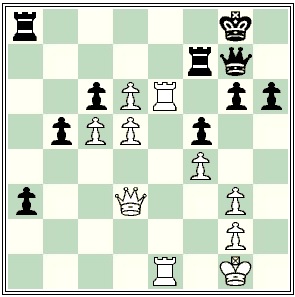
Position after 33…a3
34.Qd1
Seeing the a-pawn advance, White seems to get cold feet. Plunging on with the logical 34.dxc6 should win, e.g. 34…a2 35.d7 a1Q 36.Rxa1 Qxa1+ 37.Kh2 Qa5 38.Re8+ Kh7 39.Rxa8 Qxa8 40.c7
34…a2 35.Qa1 b4 36.R6e5 cxd5 37.c6 Qf6 38.Re8+ Rxe8 39.Rxe8+ Kg7
Wrong square for the King – instead 39…Kh7 should lead to a draw after 40.Qxa2 (best) Qxd6
40.Re5 b3 41.c7 Rf8 42.c8Q Rxc8 43.Re7+ Kg8 44.Qxf6 1-0
Although the Irish Championship did not resume until 1946, the Dunsany Premier Tourney was never held again.
No Name Total 1 2 3 4 5 6 7 8 9 10 Prize
1 G.J. Kerlin 6 * 1 0 0 = 1 1 1 1 = First
2 C.J. Barry 6 0 * = 1 1 0 1 1 1 = Second
3 A. Bourke 5.5 1 = * = = 1 = 0 = 1 Third
4 T.G. Cranston 5.5 1 0 = * = 0 = 1 1 1
5 J.J. O'Hanlon 5.5 = 0 = = * 0 1 1 1 1
6 W. Nash 5 0 1 0 1 1 * = 0 1 =
7 L.J. Close 3.5 0 0 = = 0 = * 1 0 1
8 R.T. Varian 3 0 0 1 0 0 1 0 * 0 1
9 S.A. French 3 0 0 = 0 0 0 1 1 * =
10 T.A. Vard 2 = = 0 0 0 = 0 0 = *
Play-offs for first: G.J. Kerlin 2.5-1.5 C.J. Barry


